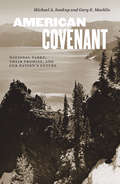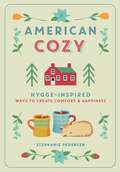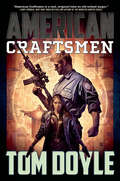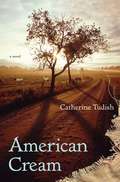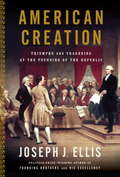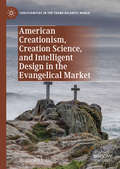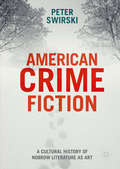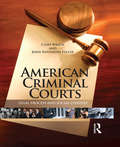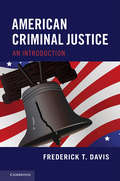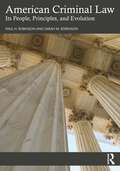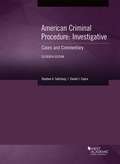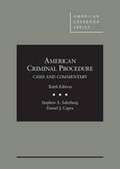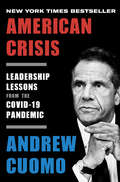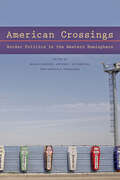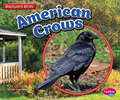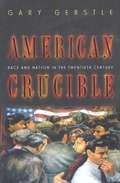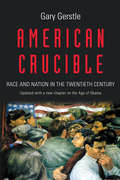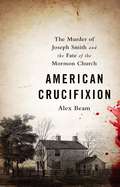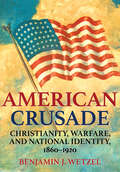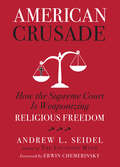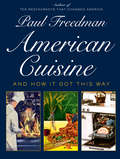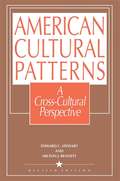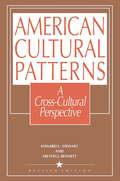- Table View
- List View
American Covenant: National Parks, Their Promise, and Our Nation's Future
by Gary E Machlis Michael A SoukupAn intimate and candid account of our national parks and their strengths, vulnerabilities, and essential role in American life Part memoir, part critique, and paean to the value of national parks, American Covenant distills the experience and insights from two long careers in conservation. Michael A. Soukup and Gary E. Machlis show how the national parks are essential to maintaining the essence of our national heritage, and key to America&’s future in a changing climate and political landscape. Sharing real-world examples of both victories and defeats in protecting national parks, this candid, thoughtful book reminds us that the national parks are a promise—a covenant—within and between generations of Americans. The book is also a call to revitalize, reconstitute, reconfigure, and reform the National Park Service, which the authors believe is governed too much by outdated management practices and politics instead of a foundation of expertise and science.
American Cozy: Hygge-Inspired Ways to Create Comfort & Happiness
by Stephanie PedersenThe wildly popular phenomenon of hygge gets a warm American twist with this gifty, illustrated guide from bestselling Danish-American author Stephanie Pedersen. With their overscheduled lifestyles, Americans can&’t always find time for the people and things they love. Enter American Cozy, which uses the Danish phenomenon of hygge—comfort, togetherness, and well-being—to bring coziness and ease to readers&’ homes, work, and lives. Filled with charming four-color illustrations, it explores organization and home décor, entertaining, cooking, creating a happier, more productive work life, de-cluttering, and slowing down.
American Craftsmen: A Novel (American Craft Ser. #1)
by Tom DoyleIn modern America, two soldiers will fight their way through the magical legacies of Poe and Hawthorne to destroy an undying evil—if they don't kill each other first.US Army Captain Dale Morton is a magician soldier—a "craftsman." After a black-ops mission gone wrong, Dale is cursed by a Persian sorcerer and haunted by his good and evil ancestors. Major Michael Endicott, a Puritan craftsman, finds gruesome evidence that the evil Mortons, formerly led by the twins Roderick and Madeline, have returned, and that Dale might be one of them.Dale uncovers treason in the Pentagon's highest covert ranks. He hunts for his enemies before they can murder him and Scherie, a new friend who knows nothing of his magic.Endicott pursues Dale, divided between his duty to capture a rogue soldier and his desire to protect Dale from his would-be assassins. They will discover that the demonic horrors that have corrupted American magic are not bound by family or even death itself. In Tom Doyle's thrilling debut, American Craftsmen, Seal Team Six meets ancient magic--with the fate of the United States hanging in the balance . . .The American Craft Trilogy#1 American Craftsmen#2 The Left-Hand Way#3 War and CraftAt the Publisher's request, this title is being sold without Digital Rights Management Software (DRM) applied.
American Cream
by Catherine TudishWhen Catherine Tudish's story collection Tenney's Landing was published in 2005, Margot Livesey said Tudish "casts an irresistible spell" and David Huddle said, "Tenney's Landing conjures up a place and a people with that magical vividness we found in Porter, Welty, Cheever, and Updike." Here, in her first novel, Tudish has fashioned a masterful and intimate portrait of a woman returning, midlife, to the small farming community where she grew up. After Nathan Rownd is injured in a tractor accident, his daughter, Virginia, leaves her suburban life and returns to Tenney's Landing with her teenage son to work the family farm. She struggles with the long periods of separation from her husband and begrudgingly relearns the insistent, exhausting cadence of farm chores. But when Nathan decides to sell the farm, Virginia realizes how deep her connection to the land is and begins to question who she is and where she belongs. Catherine Tudish's writing is a tribute to small-town America. In simple, elegant prose she captures the rhythms of everyday life and the moments of truth and transformation that are found there. American Cream is a tender and wise novel by a writer of unusual sensitivity and grace.
American Creation: Triumphs and Tragedies at the Founding of the Republic
by Joseph J. EllisFrom the prizewinning author of the best-selling Founding Brothers and American Sphinx, a masterly and highly ironic examination of the founding years of our country. The last quarter of the eighteenth century remains the most politically creative era in American history, when a dedicated and determined group of men undertook a bold experiment in political ideals. It was a time of triumphs; yet, as Joseph J. Ellis makes clear, it was also a time of tragedies--all of which contributed to the shaping of our burgeoning nation. From the first shots fired at Lexington to the signing of the Declaration of Independence to the negotiations for the Louisiana Purchase, Ellis guides us through the decisive issues of the nation's founding, and illuminates the emerging philosophies, shifting alliances, and personal and political foibles of our now iconic leaders--Washington, Jefferson, Madison, Hamilton, and Adams. He casts an incisive eye on the founders' achievements, arguing that the American Revolution was, paradoxically, an evolution--and that part of what made it so extraordinary was the gradual pace at which it occurred. He shows us why the fact that it was brought about by a group, rather than by a single individual, distinguished it from the bloodier revolutions of other countries, and ultimately played a key role in determining its success. He explains how the idea of a strong federal government, championed by Washington, was eventually embraced by the American people, the majority of whom had to be won over, as they feared an absolute power reminiscent of the British Empire. And he details the emergence of the two-party system--then a political novelty--which today stands as the founders' most enduring legacy. But Ellis is equally incisive about their failures, and he makes clear how their inability to abolish slavery and to reach a just settlement with the Native Americans has played an equally important role in shaping our national character. He demonstrates how these misjudgments, now so abundantly evident, were not necessarily inevitable. We learn of the negotiations between Henry Knox and Alexander McGillivray, the most talented Indian statesman of his time, which began in good faith and ended in disaster. And we come to understand how a political solution to slavery required the kind of robust federal power that the Jeffersonians viewed as a betrayal of their most deeply held principles. With eloquence and insight, Ellis strips the mythic veneer of the revolutionary generation to reveal men both human and inspired, possessed of both brilliance and blindness. American Creation is a book that delineates an era of flawed greatness, at a time when understanding our origins is more important than ever.
American Creationism, Creation Science, and Intelligent Design in the Evangelical Market
by Benjamin L. Huskinson‘In this compelling and thoroughly researched book, Benjamin Huskinson demonstrates that just as there is broad diversity within evangelicalism, so too there is broad diversity among “creationists.” His work on the Intelligent Design movement is superb, and he prompts me to rethink my long held conviction that Intelligent Design is merely the most recent evolutionary form of creationism. This is a very fine book.’ —Randall Balmer, Author of Evangelicalism in America and writer-host of “In the Beginning”: The Creationist Controversy ‘Benjamin Huskinson's study of American creationism will be an eye-opener for those who sit on the opposite side of the evolution debate. He shows that far from being a unified assault on Darwinism, the campaign was actually a sequence of separate movements launched by rival evangelical groups competing for influence within their own community.’ —Peter Bowler, Author of Monkey Trials and Gorilla Sermons: Evolution and Christianity from Darwin to Intelligent Design ‘A thoughtful and careful analysis that throws as much light on the diversity of American evangelicalism as it does on Christian attitudes to evolutionary theory. Huskinson offers a smart analysis of religious anti-evolution movements which neither demonises nor ridicules but seeks to understand the tenets and beliefs of a movement far more complex and multivalent than most of us appreciate. A must-read for science communicators.’ —Philippa Levine, Walter Prescott Webb Chair in History and Ideas, University of Texas at Austin, USA This book explores the cultural history of anti-evolution efforts in the United States from 1960 to the present, refuting several popular narratives about creation science in evangelical America. Separating theological terms like “creationism” from cultural movements such as “creation science” and “intelligent design” in an evangelical marketplace of ideas, it contests assumptions that evangelical movements against evolution are homogeneous, and it argues that intelligent design is not an off-shoot of the creation-science movement. It demonstrates that the rationale of creationist groups is relational as well as ideological, showing that the social function of American creationism, which is to establish the boundaries of 'orthodox' religion, is key to understanding the competing strategies of creation-science organisations.
American Crime Fiction: A Cultural History of Nobrow Literature as Art
by Peter SwirskiPeter Swirski looks at American crime fiction as an artform that expresses and reflects the social and aesthetic values of its authors and readers. As such he documents the manifold ways in which such authorship and readership are a matter of informed literary choice and not of cultural brainwashing or declining literary standards. Asking, in effect, a series of questions about the nature of genre fiction as art, successive chapters look at American crime writers whose careers throw light on the hazards and rewards of nobrow traffic between popular forms and highbrow aesthetics: Dashiell Hammett, John Grisham, William Faulkner, Ernest Hemingway, Raymond Chandler, Ed McBain, Nelson DeMille, and F. Scott Fitzgerald.
American Criminal Courts: Legal Process and Social Context
by John Randolph Fuller Casey WelchAmerican Criminal Courts: Legal Process and Social Context is an introductory-level text that offers a comprehensive study of the legal processes that guide criminal courts and the social contexts that introduce variations in the activities of actors inside and outside the court. Specifically the text focuses upon: Legal Processes. U.S. criminal courts are constrained by several legal processes and organizational structures that determine how the courts operate and how laws are applied. This book explores how democratic processes develop the criminal law in the United States, the documents that define law (federal and state constitutions, legal codes, administrative policies), the organizational structure of courts at the federal and state levels, the overlapping authority of the appeals process, and the effect of legal processes such as precedent, jurisdiction, and the underlying legal philosophies of various types of courts. Although most texts on criminal courts do a credible job of describing legal processes, this text looks more deeply into the origins of criminal law, historic turning points in the criminal law, conditions that affect the decision-making of criminal justice practitioners, and the contentious political process that affects how criminal laws are considered. Social Contexts. The criminal courts are staffed by people who represent different perspectives, occupational pressures, and organizational goals. The text includes chapters on actors in the traditional courtroom workgroup (judges, prosecutors, and defense attorneys), as well as those outside the court who seek to influence it, including advocacy groups, media, and politicians. It is the interplay between the court legal processes and the social actors in the courtroom that makes the application of the criminal laws so fascinating. By focusing on the tension between the law (legal processes) and the actors inside and outside the courts system (social contexts), this text demonstrates how the courts are a product of "law in action," and it presents the course content in a way that enables students to understand not only the "how" of the U.S. criminal court system but also the "why."
American Criminal Justice Policy
by Daniel P. MearsAmerican Criminal Justice Policy examines many of the most prominent criminal justice policies on the American landscape and finds that they fall well short of achieving the accountability and effectiveness that policymakers have advocated and that the public expects. The policies include mass incarceration, sex offender laws, supermax prisons, faith-based prisoner reentry programs, transfer of juveniles to adult court, domestic violence mandatory arrest laws, drug courts, gun laws, community policing, private prisons, and others. Optimistically, Daniel P. Mears argues that this situation can be changed through systematic incorporation of evaluation research into policy development, monitoring, and assessment. To this end, the book provides a clear and accessible discussion of five types of evaluation - needs, theory, implementation or process, outcome and impact, and cost-efficiency. It identifies how these can be used both to hold the criminal justice system accountable and to increase the effectiveness of crime control and crime prevention efforts.
American Criminal Justice: An Introduction
by Frederick T. DavisAmerican criminal justice may be one of the best known - and most influential - systems of criminal justice in the world, but also the least understood: countless films and television series portray American police officers, prosecutors and lawyers, but over 95 percent of criminal matters result in guilty pleas, and trials are becoming vanishingly scarce as people accused of crime choose to strike a deal with increasingly powerful prosecutors. Sentencing 'reform' has led to a burgeoning prison population that is by far the highest among economically advanced countries. Meanwhile, American prosecutors have gained increasing (and largely unchecked) power to apply US criminal laws to worldwide corporations and individuals with little or no connection with the country. American Criminal Justice: An Introduction provides a readable, comprehensive review of the American criminal process behind these and other problems.
American Criminal Law: Its People, Principles, and Evolution
by Paul H. Robinson Sarah M. RobinsonThis coursebook offers an exciting new approach to teaching criminal law to graduate and undergraduate students, and indeed to the general public. Each well-organized and student-friendly chapter offers historical context, tells the story of a principal historic case, provides a modern case that contrasts with the historic, explains the legal issue at the heart of both cases, includes a unique mapping feature describing the range of positions on the issue among the states today, examines a key policy question on the topic, and provides an aftermath that reports the final chapter to the historic and modern case stories. By embedding sophisticated legal doctrine and analysis in real-world storytelling, the book provides a uniquely effective approach to teaching American criminal law in programs on criminal justice, political science, public policy, history, philosophy, and a range of other fields.
American Criminal Procedure, Investigative: Cases And Commentary (American Casebook Series)
by Stephen Saltzburg Daniel CapraThis book is a complete, unchanged reprint of Chapters 1–6 of Saltzburg & Capra, American Criminal Procedure (11th ed. 2018). The new edition of the hardcover text contains detailed commentary, highlighted treatment of selected lower court cases, and full consideration of Supreme Court cases.
American Criminal Procedure: Cases and Commentary (10th Edition)
by Daniel J. Capra Stephen A. SaltzburgThis new edition of the classic casebook contains detailed and authoritative commentary, extensive discussion of practical problems, highlighted treatment of selected recent lower-court cases, full consideration of Supreme Court cases, and questions that challenge the conceptions and analytical powers of law students. New features include the addition of more headnotes; full case treatment of important new Supreme Court cases; and consideration of how Bill of Rights protections have been affected and limited in the aftermath of 9/11. The new edition also includes additional scholarly commentary on such topics as the exclusionary rule, Miranda, and jury nullification. The authors have made a concerted attempt to make the book as lean and as user-friendly as possible, without sacrificing content that will challenge both the student and the professor.
American Crisis: Leadership Lessons from the COVID-19 Pandemic
by Andrew CuomoGovernor Andrew Cuomo tells the riveting story of how he took charge in the fight against COVID-19 as New York became the epicenter of the pandemic, offering hard-won lessons in leadership and his vision for the path forward. When COVID-19 besieged the United States, New York State emerged as the global “ground zero” for a deadly contagion that threatened the lives and livelihoods of millions. Quickly, Governor Andrew Cuomo provided the leadership to address the threat, becoming the standard-bearer of the organized response the country desperately needed. With infection rates spiking and more people dying every day, the systems and functions necessary to combat the pandemic in New York—and America—did not exist. <P><P>So Cuomo undertook the impossible. He unified people to rise to the challenge and was relentless in his pursuit of scientific facts and data. He quelled fear while implementing an extraordinary plan for flattening the curve of infection. He and his team worked day and night to protect the people of New York, despite roadblocks presented by a president incapable of leadership and addicted to transactional politics. Taking readers beyond the candid daily briefings that became must-see TV across the globe, and providing a dramatic, day-by-day account of the catastrophe as it unfolded, American Crisis presents the intimate and inspiring thoughts of a leader at an unprecedented historical moment. <P><P>In his own voice, Andrew Cuomo chronicles the ingenuity and sacrifice required of so many to fight the pandemic, sharing the decision-making that shaped his policy as well as his frank accounting and assessment of his interactions with the federal government, the White House, and other state and local political and health officials. Real leadership, he shows, requires clear communication, compassion for others, and a commitment to truth-telling—no matter how frightening the facts may be. Including a game plan for what we as individuals—and as a nation—need to do to protect ourselves against this disaster and those to come, American Crisis is a remarkable portrait of selfless leadership and a gritty story of difficult choices that points the way to a safer future for all of us. <P><P><b>A New York Times Bestseller</b>
American Crossings: Border Politics in the Western Hemisphere
by Maiah Jaskoski, Arturo C. Sotomayor, and Harold A. TrinkunasWho—and what—moves from one country to another has real implications for security studies, international relations, and the ideal of democracy.In summer 2014, US agencies responsible for the border with Mexico were overwhelmed by tens of thousands of unaccompanied children arriving from Central America. Unprepared to address this unexpected kind of migrant, the US government deployed troops to carry out a new border mission: the feeding, care, and housing of this wave of children.This event highlights the complex social, economic, and political issues that arise along borders. In American Crossings, nine scholars consider the complicated modern history of borders in the Western Hemisphere, examining borders as geopolitical boundaries, key locations for internal security, spaces for international trade, and areas where national and community identities are defined. Among the provocative questions raised are: Why are Peru and Chile inclined to legalize territory disputes through the International Court of Justice, undermining their militaries? Why has economic integration in the "Tri-Border Area" of Argentina, Brazil, and Paraguay increased illicit trade supporting transnational terrorist groups? And how has a weak Ecuadorian presence at the EcuadorColombia border encouraged Colombian guerrillas to enforce the international borderline?
American Crows (Backyard Birds Ser.)
by Lisa J. AmstutzWho’s that squawking in the backyard? It’s an American crow! Find out where American crows live, what they eat, and how to identify the birds and their eggs.
American Crucible: Race and Nation in the Twentieth Century
by Gary GerstleThis sweeping history of twentieth-century America follows the changing and often conflicting ideas about the fundamental nature of American society: Is the United States a social melting pot, as our civic creed warrants, or is full citizenship somehow reserved for those who are white and of the "right" ancestry? Gary Gerstle traces the forces of civic and racial nationalism, arguing that both profoundly shaped our society. After Theodore Roosevelt led his Rough Riders to victory during the Spanish American War, he boasted of the diversity of his men's origins- from the Kentucky backwoods to the Irish, Italian, and Jewish neighborhoods of northeastern cities. Roosevelt's vision of a hybrid and superior "American race," strengthened by war, would inspire the social, diplomatic, and economic policies of American liberals for decades. And yet, for all of its appeal to the civic principles of inclusion, this liberal legacy was grounded in "Anglo-Saxon" culture, making it difficult in particular for Jews and Italians and especially for Asians and African Americans to gain acceptance. Gerstle weaves a compelling story of events, institutions, and ideas that played on perceptions of ethnic/racial difference, from the world wars and the labor movement to the New Deal and Hollywood to the Cold War and the civil rights movement. We witness the remnants of racial thinking among such liberals as FDR and LBJ; we see how Italians and Jews from Frank Capra to the creators of Superman perpetuated the New Deal philosophy while suppressing their own ethnicity; we feel the frustrations of African-American servicemen denied the opportunity to fight for their country and the moral outrage of more recent black activists, including Martin Luther King, Jr. , Fannie Lou Hamer, and Malcolm X. Gerstle argues that the civil rights movement and Vietnam broke the liberal nation apart, and his analysis of this upheaval leads him to assess Reagan's and Clinton's attempts to resurrect nationalism. Can the United States ever live up to its civic creed? For anyone who views racism as an aberration from the liberal premises of the republic, this book is must reading.
American Crucible: Race and Nation in the Twentieth Century
by Gary GerstleThis sweeping history of twentieth-century America follows the changing and often conflicting ideas about the fundamental nature of American society: Is the United States a social melting pot, as our civic creed warrants, or is full citizenship somehow reserved for those who are white and of the "right" ancestry? Gary Gerstle traces the forces of civic and racial nationalism, arguing that both profoundly shaped our society. After Theodore Roosevelt led his Rough Riders to victory during the Spanish American War, he boasted of the diversity of his men's origins- from the Kentucky backwoods to the Irish, Italian, and Jewish neighborhoods of northeastern cities. Roosevelt’s vision of a hybrid and superior “American race,” strengthened by war, would inspire the social, diplomatic, and economic policies of American liberals for decades. And yet, for all of its appeal to the civic principles of inclusion, this liberal legacy was grounded in “Anglo-Saxon” culture, making it difficult in particular for Jews and Italians and especially for Asians and African Americans to gain acceptance. Gerstle weaves a compelling story of events, institutions, and ideas that played on perceptions of ethnic/racial difference, from the world wars and the labor movement to the New Deal and Hollywood to the Cold War and the civil rights movement. We witness the remnants of racial thinking among such liberals as FDR and LBJ; we see how Italians and Jews from Frank Capra to the creators of Superman perpetuated the New Deal philosophy while suppressing their own ethnicity; we feel the frustrations of African-American servicemen denied the opportunity to fight for their country and the moral outrage of more recent black activists, including Martin Luther King, Jr., Fannie Lou Hamer, and Malcolm X. Gerstle argues that the civil rights movement and Vietnam broke the liberal nation apart, and his analysis of this upheaval leads him to assess Reagan’s and Clinton’s attempts to resurrect nationalism. Can the United States ever live up to its civic creed? For anyone who views racism as an aberration from the liberal premises of the republic, this book is must reading.Containing a new chapter that reconstructs and dissects the major struggles over race and nation in an era defined by the War on Terror and by the presidency of Barack Obama, American Crucible is a must-read for anyone who views racism as an aberration from the liberal premises of the republic.
American Crucifixion: The Murder of Joseph Smith and the Fate of the Mormon Church
by Alex BeamOn June 27, 1844, a mob stormed the jail in the dusty frontier town of Carthage, Illinois. Clamorous and angry, they were hunting down a man they saw as a grave threat to their otherwise quiet lives: the founding prophet of Mormonism, Joseph Smith. They wanted blood. At thirty-nine years old, Smith had already lived an outsized life. In addition to starting his own religion and creating his own "Golden Bible”--the Book of Mormon--he had worked as a water-dowser and treasure hunter. He’d led his people to Ohio, then Missouri, then Illinois, where he founded a city larger than fledgling Chicago. He was running for president. And, secretly, he had married more than thirty women. In American Crucifixion, Alex Beam tells how Smith went from charismatic leader to public enemy: How his most seismic revelation--the doctrine of polygamy--created a rift among his peop≤ how that schism turned to violence; and how, ultimately, Smith could not escape the consequences of his ambition and pride. Mormonism is America’s largest and most enduring native religion, and the "martyrdom” of Joseph Smith is one of its transformational events. Smith’s brutal assassination propelled the Mormons to colonize the American West and claim their place in the mainstream of American history. American Crucifixion is a gripping story of scandal and violence, with deep roots in our national identity.
American Crusade: Christianity, Warfare, and National Identity, 1860–1920
by Benjamin J. WetzelWhen is a war a holy crusade? And when does theology cause Christians to condemn violence? In American Crusade, Benjamin Wetzel argues that the Civil War, the Spanish-American War, and World War I shared a cultural meaning for white Protestant ministers in the United States, who considered each conflict to be a modern-day crusade. American Crusade examines the "holy war" mentality prevalent between 1860 and 1920, juxtaposing mainline Protestant support for these wars with more hesitant religious voices: Catholics, German-speaking Lutherans, and African American Methodists. The specific theologies and social locations of these more marginal denominations made their ministries highly critical of the crusading mentality. Religious understandings of the nation, both in support of and opposed to armed conflict, played a major role in such ideological contestation. Wetzel's book questions traditional periodizations and suggests that these three wars should be understood as a unit. Grappling with the views of America's religious leaders, supplemented by those of ordinary people, American Crusade provides a fresh way of understanding the three major American wars of the late nineteenth and early twentieth centuries.
American Crusade: How the Supreme Court Is Weaponizing Religious Freedom
by Andrew L SeidelIs a fight against equality and for privilege a fight for religious supremacy? Andrew L. Seidel, a constitutional attorney and author of the critically acclaimed book The Founding Myth: Why Christian Nationalism Is Un-American, dives into the debate on religious liberty, the modern attempt to weaponize religious freedom, and the Supreme Court's role in that &“crusade.&” Seidel examines some of the key Supreme Court cases of the last thirty years—including Masterpiece Cakeshop v. Colorado Civil Rights Commission (a bakery that refused to make a wedding cake for a gay couple), Trump v. Hawaii (the anti-Muslim travel ban case), American Legion v. American Humanist Association (related to a group maintaining a 40-foot Christian cross on government-owned land), and Tandon v. Newsom (a Santa Clara Bible group exempted from Covid health restrictions), as well as the recent overturning of Roe v. Wade—and how a hallowed legal protection, freedom of religion, has been turned into a tool to advance privilege and impose religion on others. This is a meticulously researched and deeply insightful account of our political landscape with a foreword provided by noted constitutional scholar Erwin Chemerinsky, author of The Case Against the Supreme Court.The issue of church versus state is more relevant than ever in today&’s political climate and with the conservative majority status of the current Supreme Court. This book is a standout on the shelf for fans of Michelle Alexander, Bob Woodward, and Christopher Hitchens. Readers looking for critiques of the rise of Christian nationalism, like Jesus and John Wayne, and examinations like How Democracies Die will devour Seidel's analysis.Hardcover with dust jacket; 320 pages; 9 in H by 6 in W.
American Crusade: Our Fight to Stay Free
by Pete HegsethJoin the political and cultural fight for America's freedom -- and learn how to protect our nation from the leftist agenda -- with this essential guide from Fox & Friends Weekend co-host Pete Hegseth. <P><P>In American Crusade, Pete Hegseth explores whether the election of President Donald J. Trump was sign of a national rebirth, or instead the final act of a nation that has surrendered to Leftists who demand socialism, globalism, secularism, and politically-correct elitism. Can real America still win? And how? <P><P>Hegseth is an old-school patriot who is on a mission to do his part to save our Republic. This book celebrates all that America stands for, while motivating and mustering fellow patriots to stand ready to defend -- and save -- our great country. As he travels around the country talking to American citizens from all walks of life, Hegseth reveals the common wisdom of average Americans -- and how ready they are to join the cultural battlefield. <P><P> Now is that time, and Hegseth has written the playbook. American Crusade is written with the same insight, politically incorrect candor, and humor that has made his television show one of the most highly-rated in America. <P><P><b>A New York Times Bestseller</b>
American Cuisine: And How It Got This Way
by Paul FreedmanWith an ambitious sweep over two hundred years, Paul Freedman’s lavishly illustrated history shows that there actually is an American cuisine. For centuries, skeptical foreigners—and even millions of Americans—have believed there was no such thing as American cuisine. In recent decades, hamburgers, hot dogs, and pizza have been thought to define the nation’s palate. Not so, says food historian Paul Freedman, who demonstrates that there is an exuberant and diverse, if not always coherent, American cuisine that reflects the history of the nation itself. Combining historical rigor and culinary passion, Freedman underscores three recurrent themes—regionality, standardization, and variety—that shape a completely novel history of the United States. From the colonial period until after the Civil War, there was a patchwork of regional cooking styles that produced local standouts, such as gumbo from southern Louisiana, or clam chowder from New England. Later, this kind of regional identity was manipulated for historical effect, as in Southern cookbooks that mythologized gracious “plantation hospitality,” rendering invisible the African Americans who originated much of the region’s food. As the industrial revolution produced rapid changes in every sphere of life, the American palate dramatically shifted from local to processed. A new urban class clamored for convenient, modern meals and the freshness of regional cuisine disappeared, replaced by packaged and standardized products—such as canned peas, baloney, sliced white bread, and jarred baby food. By the early twentieth century, the era of homogenized American food was in full swing. Bolstered by nutrition “experts,” marketing consultants, and advertising executives, food companies convinced consumers that industrial food tasted fine and, more importantly, was convenient and nutritious. No group was more susceptible to the blandishments of advertisers than women, who were made feel that their husbands might stray if not satisfied with the meals provided at home. On the other hand, men wanted women to be svelte, sporty companions, not kitchen drudges. The solution companies offered was time-saving recipes using modern processed helpers. Men supposedly liked hearty food, while women were portrayed as fond of fussy, “dainty,” colorful, but tasteless dishes—tuna salad sandwiches, multicolored Jell-O, or artificial crab toppings. The 1970s saw the zenith of processed-food hegemony, but also the beginning of a food revolution in California. What became known as New American cuisine rejected the blandness of standardized food in favor of the actual taste and pleasure that seasonal, locally grown products provided. The result was a farm-to-table trend that continues to dominate. “A book to be savored” (Stephen Aron), American Cuisine is also a repository of anecdotes that will delight food lovers: how dry cereal was created by William Kellogg for people with digestive and low-energy problems; that chicken Parmesan, the beloved Italian favorite, is actually an American invention; and that Florida Key lime pie goes back only to the 1940s and was based on a recipe developed by Borden’s condensed milk. More emphatically, Freedman shows that American cuisine would be nowhere without the constant influx of immigrants, who have popularized everything from tacos to sushi rolls. “Impeccably researched, intellectually satisfying, and hugely readable” (Simon Majumdar), American Cuisine is a landmark work that sheds astonishing light on a history most of us thought we never had.
American Cultural Patterns: A Cross-Cultural Perspective
by Milton J. Bennett Edward C. StewartThis classic study was originally written by Edward Stewart in 1972 and has become a seminal work in the field of intercultural relations. In this edition, Stewart and Milton J. Bennett have greatly expanded the analysis of American cultural patterns by introducing new cross-cultural comparisons and drawing on recent reseach on value systems, perception psychology, cultural anthropology, and intercultural communication. Beginning with a discussion of the issues relative to contact between people of different cultures, the authors examine the nature of cultural assumptions and values as a framework for cross-cultural analysis. They then analyze the human perceptual process, consider the influence of language on culture, and discuss nonverbal behavior. Central to the book is an analysis of American culture constructed along four dimentions: form of activity, form of social relations, perceptions of the world, and perception of the self. American cultural traits are isolated out, analyzed, and compared with parallel characteristics of other cultures. Finally, the cultural dimentions of communication and their implications for cross-cultural interaction are examined.
American Cultural Patterns: A Cross-Cultural Perspective
by Milton J. Bennett Edward C. StewartThis classic study was originally written by Edward Stewart in 1972 and has become a seminal work in the field of intercultural relations. In this edition, Stewart and Milton J. Bennett have greatly expanded the analysis of American cultural patterns by introducing new cross-cultural comparisons and drawing on recent reseach on value systems, perception psychology, cultural anthropology, and intercultural communication. Beginning with a discussion of the issues relative to contact between people of different cultures, the authors examine the nature of cultural assumptions and values as a framework for cross-cultural analysis. They then analyze the human perceptual process, consider the influence of language on culture, and discuss nonverbal behavior. Central to the book is an analysis of American culture constructed along four dimentions: form of activity, form of social relations, perceptions of the world, and perception of the self. American cultural traits are isolated out, analyzed, and compared with parallel characteristics of other cultures. Finally, the cultural dimentions of communication and their implications for cross-cultural interaction are examined.
